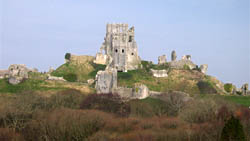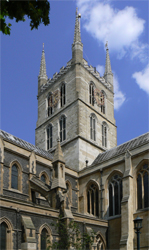William Charles BARNES, the third son of George BARNES and Mary BENFIELD,
was baptised on 25 August 1811 in Worth Matravers, Dorset.[1,2]
Worth Matravers is a coastal village close to Corfe Castle and Swanage on what is known
as the Isle of Purbeck, an area known for the quarrying
of the famous Purbeck stone. William’s mother, Mary,
died when her youngest child was only three years old so
George was left to look after his young family.
|
| |
| |
The
village pond in Worth Matravers |
| |
William, like many of the inhabitants of Worth Matravers,
became a stone mason working the local Purbeck stone
like his father, George, and his brothers Thomas Northover
BARNES, George BARNES and Samuel BARNES. He probably started working in the industry when
he was about ten years old. He could write his name and
so it was likely that he had some formal education. It was
the quarrymen’s job to cut the large blocks of Purbeck
marble from the quarry; the large pieces of rough stone were
then brought to the stone masons for them to shape
into building blocks or floor slabs before being transported
to the purchaser. Cutting and shaping the blocks was a slow
and skilled job – dust filled the air and accidents were
not uncommon. The quarrying of purbeck marble had been going
on for many hundreds of years and copies of sixteenth and seventeenth
century documents detailing the very strict Bylaws of the
Ancient Order of Purbeck Marblers and Stone Cutters can
be found on the uk-genealogy.org.uk website.
These documents are signed by the members of the Company
of Marblers, one of whom was Edward Barnes – possibly
one of William's ancestors.
 |
| |
Corfe
Castle |
|
| |
One unusual custom, which continues to this day, is the
Shrove Tuesday Football Ceremony of the Purbeck Marblers.
Shrove Tuesday was the day that the new apprentices were
accepted into the Ancient Order of Purbeck Marblers and
Stone Cutters and after the annual meeting the new freemen
had to kick a football through the village of Corfe Castle,
some say with a glass of beer which others tried to spill.
Maybe William and his brothers took part in this ceremony but they would certainly have joined in the celebrations.
Sometime before the summer of 1839 William left his home
village of Worth Matravers and travelled to Newport in South
Wales. At this time the town was a relatively poor area but
people were pouring in from all over Wales, looking
for work, including many Irish immigrants who were leaving
Ireland in search of a better life. Some found work helping
to build the new dock in Pillgwenlly, an area of Newport.
William may have been one of those men who went to the new docks, perhaps tempted by better pay
than in Purbeck.
The Newport Dock Act had been given Royal Assent in July 1835,
allowing the Newport Dock Company to begin construction
work later that year. The cost was estimated to be £35,000.
However, the cost soon began to rise rapidly and the project
suffered many labour disputes and unrest. In 1838 more money
was raised and it may have been at this time that William
joined the venture.
It was in Newport that William met and fell in love with
Jane Lewis, a young girl eight years his junior who had
been born in Cardiff, Glamorgan, Wales[3], the daughter
of John Lewis, a plasterer. William stayed in Wales and
in June 1839 Jane and William married in the parish church
of St Woollos in Newport.[4] This old parish church was, until about 1836, the only church
for the inhabitants of Newport and in 1839 was still the
parish church for the area of Pillgwenlly where William
and Jane were living. On their marriage certificate William described himself as a stone mason
and the fact that they were living in the area of the new docks
is consistent with William working there
Another possible reason for William’s move to Newport
may have been an interest in the Chartist movement. The
Chartists were a group of, mainly, working class men who
wanted the vote for all men, Parliamentary reform and hence
an improvement in life for the working classes. They were
becoming very strong and active in Newport at about the
time that William went to live there. A few months after
William and Jane’s marriage, Newport was the scene
of a formidable Chartist riot. John Frost and other leading
Chartists were joined by about 10,000 miners from the nearby
collieries and mines, armed with pikes, guns, swords and
clubs. The mayor, having failed to persuade the rioters
to go home, read the Riot Act from the window of the Westgate
Hotel but he was fired upon by someone in the crowd. Troops returned fire and shot twenty of the miners dead,
dispersing the rest. John Frost, and the others who were
captured, were tried and convicted and sentenced to death;
the sentence was, however, subsequently commuted to penal
servitude, and a pardon was granted in 1856.[5] There is
no evidence that William was amongst these men but he could not have missed being aware of the disturbances in the town and the Chartist movement.
Jane was soon pregnant and their first child, Eliza, was
born in the spring of 1840 and registered in the Cardiff
Registration District.[6] But William and Jane did not stay
in Wales to see the opening of the docks. Work had been
halted in December 1840 following the failure
of yet another contractor and William may have been laid off
at this time. Financial problems and industrial unrest continued
to plague the dock's construction to the very end. In September
1842 a further £10,000 had to be borrowed when workers
walked out demanding higher wages, an event which led to
a body of well armed police being sent to quell the disturbance.
The official opening of the Dock on 10 October 1842
was marked by a programme of festivities that attracted
tens of thousands of visitors to the town. The final cost
of the dock was estimated to have been £200,000, rather
more than the original estimate of £35,000.
If William did lose his job in Wales in December 1840 he
soon found work in another dock. By the time of the 1841
census William and his young family had moved to Henry Street,
Woolwich Dockyard, Kent where they were living with William’s
brother, Samuel, and another William and Elizabeth Barnes.[7]
Not all men were so lucky – the Monmouth Merlin of
February 1841 describes “one of the poor fellows
who was recently discharged from the Dock Works, and who
has since been unable to obtain employment, is now suffering
the most terrible destitution at Pillgwenlly” it goes
on to say that his wife and four helpless children were
starving having “subsisted entirely on boiled turnips
and a four penny loaf during the last seven days, and numerous
other families are in the same condition”.
Although William and Jane missed the festivities at the opening of the dock in Newport they had probably joined in the earlier big celebration at the Woolwich Dockyard on 21 June 1841 to launch HMS Trafalgar. Queen Victoria and the Prince Consort attended, and there was a carnival atmosphere in the town, with the sea filled with
small boats all celebrating both the launch and the Royal visit.
 |
| |
|
| |
When William and Jane’s first son, also William,
was born in 1844 the family had moved again, this time to
Southwark in London.[8] They were still in Southwark when
their daughter, Mary Ann, was born three years later and William may
have been working on the Purbeck marble floor of Southwark
Cathedral. In about 1849 William and Jane had another son,
John, who, according to the 1851 census, was born in Portsmouth,
Hampshire.[9] William may have been working in Portsmouth
or just visiting but by the time of the 1851 census the family
had moved again, this time back to London and to 1 Melville Place, Clerkenwell.
William again described himself as a stone mason (journeyman).[10]
Another son, James, was born later in 1851 but back in Southwark.[11]
On the night of the census in 1851 William’s brothers, George and Thomas, were still
in Woolwich with Thomas’ wife and five children and
cousin Alfred. Their father, George, was visiting from Worth
Matravers.[12]
William's and Jane's last three children were all born in Clerkenwell;
Emma in 1855[13] Helen, known as 'Ellen' three years later[14],
and the youngest, Charles, was born in January 1861.[15] In the census taken on 7 April 1861 the family was living
at 1 Wood St, Grays End Lane, St Pancras. William continued to be recorded
as a stone mason.[16]
Two years later, in March 1863, William
became ill. The symptoms would have meant that Jane and
William knew the prognosis immediately and it must have
struck fear in the heart of Jane, at the prospect of having
to bring up such a young family without the main income.
Jane was present when, 16 months later on 9 July 1864, William
died of phthisis, a lung disease. It was probably Silicosis, one of the
world's oldest known occupational diseases, often called
grinders' asthma, grinders' dust consumption, grinders'
rot, masons' disease, miner's asthma, miner's phthisis,
potters' rot, or stonemason's disease. He was only 53 years
old.[17]
Sometime after William’s death, Jane moved to 205 Kings Cross Road, St Pancras and by the census on 2 April 1871 she was earning a living as a laundress in St Pancras.[18]
She died in the spring of 1874, in Pancras, aged 54.[19]
Sources
1 Dorset Online Parish Clerks
2 Family History Online. Dorset Baptisms.
3 UK Census 1841. Cit. Date: 6 June 1841
4 Marriage certificate of William Barnes and Jane Lewis
5 http://www.newportpast.com/nfs/y40t49/y1841.htm, May 2007
6 FreeBMD
7 UK Census 1841, HO107/493/3 p11, Date: 6 June 1841
8 Census Information
9 Census Information
10 UK Census 1851. Cit. Date: 30 March 1851.
William Charles Barnes Head 38 stone mason (journeyman)
Worth, Dorset
Jane Barnes Wife 37 Cardiff Wales
Eliza Barnes Dau 11 Scholar Cardiff Wales
William Barnes Son 8 Scholar Southwark, London
Mary Ann Barnes Dau 4 Scholar Southwark, London
John Barnes Son 2 Portsmouth, Hants
11 Census Information
12 UK Census 1851. Cit. Date: 30 March 1851.
13 Birth Index at PRO
14 Census Information
15 Census Information
16 UK Census 1861 (Ancestry.co.uk).
Cit. Date: 7 April 1861.
Text From Source: Name Related Age Occupation Birth Place
William Barnes Head 49 stone mason Lambeth, Surrey
Jane Barnes Wife 45
Eliza Barnes Dau 20 servant Lambeth, Surrey
William Barnes Son 17 stone servant Southwark, London
Mary Barnes Dau 14 servant Southwark, London
James Barnes Son 10 Scholar Southwark, London
Emma Barnes Dau 6 Scholar Clerkenwell, London
Helen Barnes Dau 3 Clerkenwell, London
Charles Barnes Son 3 mths Clerkenwell, London
17 Death certificate of William Charles Barnes
18 UK Census 1871 (Ancestry.co.uk). Cit. Date: 2 April 1871.
Text From Source: Name Related Age Occupation Birth Place
Jane Barnes Head 60 laundress
James Barnes Son 19 stone mason Southwark, London
Emma Barnes Dau 16 artificial florist Clerkenwell, London
Helen Barnes Dau 14 artificial florist Clerkenwell, London
19 FreeBMD (http://freebmd.rootsweb.com/).
Other Sources
1. Parish Records reference X105/020
2. London Metropolitan Archives, London Metropolitan Archives,
40 Northampton Road, London EC1R OHB.
3. Lyn Scadding, "Scadding family" (www.scadding.net/SOMSC001).
4. http://www.newportpast.com/nfs/y40t49/y1841.htm
5. http://www.uk-genealogy.org.uk/genuki/DOR/CorfeCastle/articles.html Bylaws of the Marblers of Corfe Castle, Co. Dorset renewed and confirmed 3rd March 1651